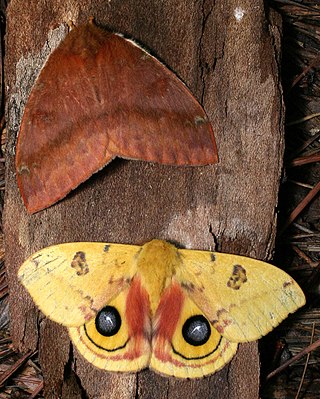
Fraxinus pennsylvanica, the green ash or red ash, is a species of ash native to eastern and central North America, from Nova Scotia west to southeastern Alberta and eastern Colorado, south to northern Florida, and southwest to Oklahoma and eastern Texas. It has spread and become naturalized in much of the western United States and also in Europe from Spain to Russia.

Automeris io, the Io moth or peacock moth, is a colorful North American moth in the family Saturniidae. The Io moth is also a member of the subfamily Hemileucinae. The name Io comes from Greek mythology in which Io was a mortal lover of Zeus. The Io moth ranges from the southeast corner of Manitoba and in the southern extremes of Ontario, Quebec, New Brunswick and Nova Scotia in Canada, and in the US it is found from Montana, North Dakota, South Dakota, Nebraska, Colorado, New Mexico, Texas, Utah, east of those states and down to the southern end of Florida. The species was first described by Johan Christian Fabricius in 1775.

Berberis thunbergii, the Japanese barberry, Thunberg's barberry, or red barberry, is a species of flowering plant in the barberry family Berberidaceae, native to Japan and eastern Asia, though widely naturalized in China and North America, where it has become a problematic invasive in many places, leading to declines in species diversity, increased tick habitat, and soil changes. Growing to 1 m tall by 2.5 m broad, it is a small deciduous shrub with green leaves turning red in the autumn, brilliant red fruits in autumn and pale yellow flowers in spring.

The Hydropsychidae are a family-level taxon consisting of net-spinning caddisflies. Hydropsychids are common among much of the world's streams, and a few species occupy the shorelines of freshwater lakes. Larvae of the hydropsychids construct nets at the open ends of their dwellings which are responsible for their "net-spinning caddisfly" common name.

Lysimachia ciliata, the fringed loosestrife, is a species of flowering plant in the family Primulaceae. It is an erect herbaceous perennial growing to 120 cm (47 in) tall and 60 cm (24 in) broad, with opposite, simple leaves, and smooth green stems. The star-shaped yellow flowers are borne in midsummer. It is native to North America, including most of southern Canada and most of the United States except for the southwest. This plant is notable in that it is one of the few species of Lysimachia to bear elaiophores, that is, to offer oil instead of nectar as a reward to pollinators. It is pollinated in the northern part of its range by the specialist oil bee Macropis nuda, a native bee species whose survival depends upon this host plant.
Swavesey Village College is a village college and academy school in the village of Swavesey in south Cambridgeshire, England. In 2011, Swavesey Village College became an Academy and established the Cambridge Meridian Academies Trust.

Macropis is a genus of bees in the family Melittidae.

Leucanthiza dircella is a species of moth in the family Gracillariidae. It is known from Canada, and the United States.

Epeoloides is a genus of cuckoo bees which lay their eggs in the nests of melittid bees of the genus Macropis. One species, Epeoloides pilosulus, is classified as Endangered by the State of Connecticut.

Epeoloides pilosulus is one of only two species in the bee genus Epeoloides; it is cleptoparasitic in the nests of melittid bees of the genus Macropis. Known to exist in only a handful of localities in the northeastern United States and adjacent parts of Canada, this species is classified as Endangered by the State of Connecticut.
Refugees in Jordan rose with the uprising against the Syrian government and its President Bashar al-Assad. Close to 13,000 Syrians per day began pouring into Jordan to reside in its refugee camps.

Macropis nuda is a ground nesting, univoltine bee native to northern parts of North America. Thus, this species cocoons as pupae and hibernates over the winter. The species is unusual as it is an oligolectic bee, foraging exclusively for floral oils and pollen from Primulaceae of the species Lysimachia ciliata.

Xyleborus affinis, the sugarcane shot-hole borer, is a species of ambrosia beetle in the family Curculionidae. It is found on all continents with woodlands and is one of the most widespread ambrosia beetles internationally, primarily in areas with humid tropical climates like Florida. Like other ambrosia beetles, Xyleborus affinis is attracted to dead fallen logs in early stages of decay. Due to the presence of X. affinis on moist timber, this species is mistakenly believed to be the cause of tree death. However, there is insufficient evidence to support their presence as a causal factor. Rather, these beetles are believed to target and accelerate the decay process of trees that are already deteriorated and weak.
Aulacus burquei is a species of parasitoid wasp in the family Aulacidae. It is found in North America.It's only known host is Xiphydria. A. burquei lays its egg within the eggs of its host.

Ancistrocerus antilope is a species of wasp of the family Vespidae.

Atanycolus is a genus of braconid wasps. Species in this genus are parasitoids of beetles from families Buprestidae and Curculionidae.

Leucospis affinis is a species of parasitic wasp of megachilid bees. The species Ancistrocerus antilope is also a host. It can be found in North America.

Diastrophus nebulosus is a species that forms galls. Its common name is the blackberry knot gall wasp. Its host plant is Rubus flagellaris.

Telamona reclivata is a species of treehopper in the family Membracidae.
















